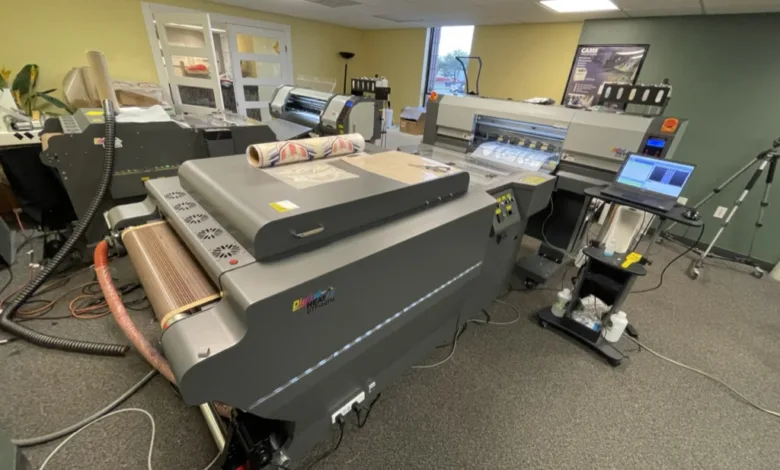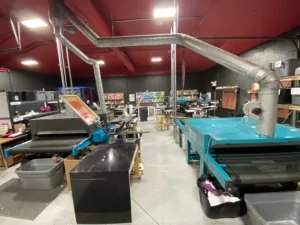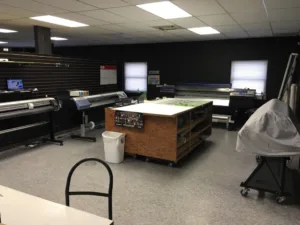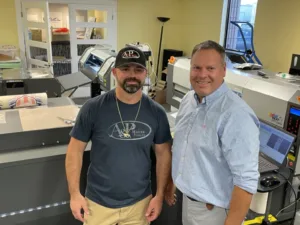
Over the past 20 years, our company has always been on the lookout for the latest and greatest printing techniques and the newest equipment to not only make things easier for our crew, but to offer more options to our customers. Twenty years ago, sublimation was the very first process our company offered from our home and many did not know what it was or how well it would last. All these years later, everyone is promoting it, which is great to see! But what’s next? You guessed it: direct to film (DTF).

I will be the first to admit that, when I heard about the process last year, I discounted it without doing any research. To me it sounded like another direct-to-garment knock-off, and I had studied that process for several years hoping it would advance. However, several months ago I was going through my emails and a manufacturer was promoting their DTF printer. It caught my eye right away. I spent the next couple of hours doing some research on the process and the films, inks, and adhesive powders generally used. With any new process everyone always tells you what you want to hear, so I always try to dig deeper since we are the ones making the investment.
After some research, I found a company that sold DTF prints, so we had some made to test them. On top of that, I reached out to ColDesi to order sample prints from their DTF machine to compare the print quality and see how well they would hold up. Both sets of prints were tested and both held up well in the wash, but the ColDesi prints had better-quality ink saturation and level of detail, with no lines or fuzziness on the print.

From there I did a Zoom call with Michael Angel, Business Development, from ColDesi to learn more details about their DTF equipment. I have worked with ColDesi for years – ever since we first searched for quality rhinestones – and they have always been about quality and customer service, which is another reason I trust them right out of the gate. Angel explained to me the mechanics of how the machine operated, what I needed to set the equipment up, and more. After running the tests and having a great Zoom meeting, my wife and I made plans to fly down to the ColDesi facility right away for an in-person demo. Once we saw the DTF printer working in real life and talked to Angel and his team some more, it took us only 20 minutes to decide that this was the machine for us. We had already met with our bank for pre-approval for a loan, so we were able to get everything rolling to order the machine that day.
I know what you are thinking … Great, you invested in a new process, but why? What does this new process bring to the table?
Before I explain that, let’s go over a few different printing options we offer to our customers for comparison:
Sublimation is a great process for full-color printing of small or large runs, but when it comes to apparel, it only works well on 100% polyester. The sublimation process is very clean, though, and takes up very little space. We offered this process in our online stores.
Apparel vinyl is a process we offered to be able to put full-color images on any fabric for our online stores, but it was not a perfect solution since it can be time consuming to print, die-cut, weed, transfer, and then heat press the product. It is a good process overall to get you by, but not the most cost-effective one in the end, though it also takes up very little space.
Screen printing is one of the older printing processes on the market and still a top-quality option, but it can take up much more space and isn’t very clean. You need space to print your positives and clean, spray out, and expose screens, plus a dark room/dryer room and space to print. Around 14 years ago, when we started in screen printing, our original print area was only 600 square feet. Today it is no more than 1,200 square feet. With screen printing you can print onto just about any fabric, but the issues are curing the ink and avoiding dye migration with some of the chemicals being used in the dyes of the fabrics. Another issue is how long it takes to train someone on the entire process of screen printing and the attention to detail that it requires. Then you have the amount of space and supplies needed. Again, still a top-notch, quality process, hands down.
So again, why DTF? You have so many options already …
I thought the same thing until I completed my research. This was the one process that helped my entire company, starting with customer service. They no longer have to sell by number of colors or worry about PMS matches, and this goes on just about any fabric. And, it takes less time to train a new rep on how to sell DTF. With the other processes, you have so much more to explain, like what they can or cannot go on, number of colors that can be printed, etc.
From a design perspective, the designers do not have to worry about color limitations with DTF. Most customers’ logos are two to four colors, which makes it difficult at times to reduce the colors down to one or two for other processes. DTF also means the designer no longer has to worry as much about how small the design is since it is a digital print, whereas with apparel vinyl you can only go so small and have to take the time to create cut files as well as print files. On the screen-printing side, there was even more to worry about with creating positives for the designs, which is time consuming. With DTF, the designers can put all of their energy into the customer and the designs.

Let’s talk production. A DTF printer prints to a roll and then all you have to do is trim the transfers and heat press them on to the product, which is literally only a 15-second press. We have been able to press apparel at 270 degrees for as little as 10 seconds on some products. Why is this great news? You can now provide full-color prints on just about any fabric and avoid dye migration altogether. You can also heat press a minimum of 40 to 100 full-color prints per hour depending on your placement and the item. Even 40 full-color prints per hour is huge. Think about it. With sublimation, you can typically get around 24 per hour and can only offer white apparel that is only polyester. With screen printing you have to worry about dye migration much more often along with the length of training, and if you wanted a full-color print, using a six-color manual or auto would only get you 24 to 48 pieces printed per hour at most. It is much easier to simply teach someone how to operate a heat press, explain placements, and have them produce. Not to mention heat presses take up much less space than screen-printing presses.
DTF solves so many printing issues, but what’s the best part of all? You can print as many prints as you would like while printing for any and all customer orders and the cost per square inch is the same, no matter the size of your shop. This is a must-have process for all shops. And, the DTF equipment comes in a few different sizes. Our company went with the largest one to start since we knew with our volume, we could use it. Here’s to the future of printing.




